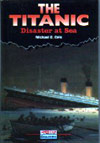 |
Cole, Michael D. The Titanic: Disaster at Sea. 1st printing. Berkeley Heights, NJ: Enslow Publishers. April, 2001. hardcover. a volume in the American Disasters series. children’s book. isbn: 0766015572. scarcity: fairly common.
This is listed with two subtitles: Death of the Dream Ship and Disaster at Sea, though both titles have the same isbn number.
It is a fairly brief work, which takes just four chapters to tell the entire Titanic story, plus a fifth chapter on the discovery of the wreck. There is quick one page look at other nautical disasters. One plus is that there are reference notes attributing sources, unusual in a book for young readers. There is also a short list for further reading; oddly the books mentioned in the notes are not listed in the bibliography.
Still, at just 48 pages, this book seems very expensive at its retail price of $18.95. Plus I had some serious issues with the text. The writing style is in a fairly sterile, just-the-facts format that actually makes the event seem rather dull. Worse are the many mistakes I found in the text. Here is a list of the major errors I caught:
On page 12 the author states “Even if three of the sixteen watertight compartments became filled with water, the ship would still stay afloat”. Actually the ship could stay afloat if any two compartments were flooded, or if any three of just the first five compartments.
Also on this page is Captain Smith’s famous quote “I cannot conceive of any vital disaster happening to this vessel. Modern shipbuilding has gone beyond that”. The author insinuates that Smith is talking about Titanic, but the captain gave this quote years earlier about an entirely different ship.
On page 23, there is the statement “The ship’s general alarm was never sounded. The alarm might have caused a panic among the passengers.....”. Titanic did not have an alarm, general or otherwise, to sound.
On page 25 the text has Second Officer Lightoller in charge of the starboard lifeboats and First Officer Murdoch in charge of the port boats. Actually, the reverse is correct, Lightoller on the port side, Murdoch on the starboard.
On page 32 there is the statement “Boilers within the ship exploded, killing crewmen and passengers who were still below”. There is no solid evidence that any boilers exploded and a great deal of proof they did not.
Then on page 33, “The Carpathia shot flares into the sky to alert other ships that the survivors had been found”. Wrong again. Carpathia did fire off flares, but she did so to alert the Titanic’s passengers and crew that help was rushing to their aid.
Again on page 33, “Many of the lifeboats were close to sinking by the time the Carpathia got to them”. There was an overturned collapsible men were standing on that was in serious trouble, and one of the other lifeboats was so overcrowded that it was wallowing dangerously; does that qualify as many?
Page 35 “ The White Star Line hired a ship from Nova Scotia to search for bodies....”. In reality, four ships were sent out for this purpose, not just one.
Finally on page 37 is this, “During the hours after the collision, the Californian was the only ship that passed near the Titanic”. In fact the Californian was stopped for the night. You can argue (any many do!) whether Californian was close enough to help or not, but stating that the ship ‘passed’ the Titanic is not only wrong, its misleading.
Because of the uninspired style of the writing, and the many errors in the text, I cannot recommend this book to any but the most avid completist collectors (and we know who we are). Especially at that high retail price.
|